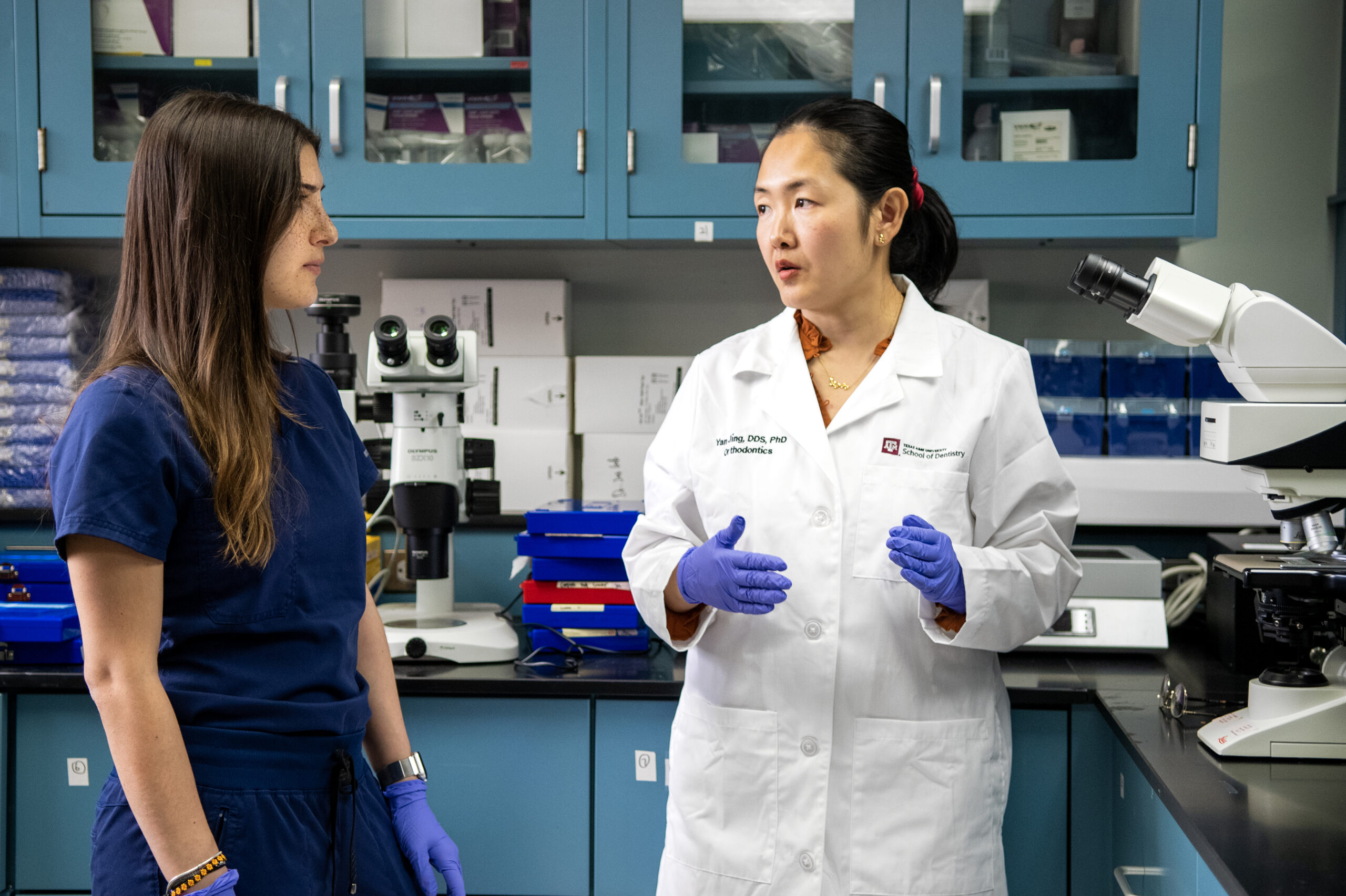Progress Notes: Dr. Yan Jing

Dr. Yan Jing started school at 6 years old and never left the classroom.
The diligent student grew into an astute scientist, who is not only playing a key role in groundbreaking research at Texas A&M School of Dentistry, but is also leading the next generation of young minds as assistant professor in the Department of Orthodontics.
“I’m in the process of transitioning to an independent researcher and also a role model for the younger generation,” Jing said. “I never thought I’d be a teacher, but being firmly rooted in the academic world, I’ve found the new role fulfilling.”
Steadfast scientist
Jing grew up in China and first became interested in dentistry in high school. She received her DDS in 2008 from Xi’an Jiaotong University in Xi’an, Shaanxi, China.
“We have five years of training for a DDS, and during that time, I became fascinated with the orthodontics field and the movement of teeth,” she said.
Jing completed her master’s degree in orthodontics in 2011 at Sichuan University in Chengdu, Sichuan, China. She started a three-year PhD program in China, but during the second year, decided to join the research program at Texas A&M School of Dentistry. As a jointly trained student, she received her PhD in orthodontics from Sichuan University in 2014. Jing is trained in both basic and clinical sciences linked to the biology of the jawbone and orthodontics.
“When I was trained in China as a master’s student, my project was a clinical study related to TMJ,” she said. “We wanted to determine if there was any TMJ condyle discrepancy before and after functional appliances. As it turned out, TMJ was one of the focuses of Dr. [Jian] Feng’s lab [at TAMSOD], and I really wanted to be involved.”
After finishing her thesis, Jing continued working in the lab as a postdoc and joined the school’s faculty in 2016.
“Our overall focus is craniofacial biology and disease, but my lab focuses on TMJ – the development and disease,” she said. “Two breakthrough findings included the discovery that cartilage cells can change into bone, and tendon cells can change into cartilage and bone. This is in a normal development range; we’re also interested to see how the cells are affected in abnormal situations like disease.”
Jing currently has two grants from the National Institute of Dental and Craniofacial Research for $615,150 and $ 1,893,750, respectively. The first is investigating the ability of cartilage cells to form bone during normal development and as a grafting treatment for trauma- or cancer-induced tissue damage in the jawbone. The second is studying the roles of tendons in forming bone cells, which are distinct from conventional bone cells, and the role tendons play in TMJ trauma repair and the onset of ankylosis, which is when the joints become stiff or immobile.
Jing said TMJ trauma is an issue with children because some kids recover with no treatment, while others develop ankylosis, severely affecting their quality of life.
“Right now we have no idea why these patients have this, and secondly, how we’re going to treat it, so that’s what we’re working on right now,” she said.
Through the years, Jing’s work has landed her on a national stage with numerous awards and publication credits. A few highlights include winning the John Haddad Young Investigator Award through Advances in Mineral Metabolism and the American Society for Bone and Mineral Research in 2018. In 2017, she and Feng won the William J. Gies Award for Biological Research in the Journal of Dental Research for the paper: “Chondrocytes Directly Transform into Bone Cells in Mandibular Condyle Growth.” They were also awarded JDR’s Cover of the Year in 2015 for the same paper.
Most recently, she received the 2022 Research Excellence Award from the dental school.
“I’m very honored,” Jing said. “As Dr. García listed all my achievements at the awards ceremony, I knew they were all true, but it’s not just me. I honestly couldn’t have made it without the support of my mentors, my team members and the school.”
Jing said she also feels lucky because her research work yielded the results she hypothesized.
“The beautiful hypothesis may not always be able to turn into a real story,” she said. “That’s part of the research. It’s not like you can see the end, and many times the results will be unexpected in a negative way. I am lucky that I got results as I expected, and my research was recognized by peers; this makes me excited.”
Evolving educator
Although the awards and accolades are an honor, Jing said what excites her most about the next chapter of her career is sharing her knowledge with students and guiding other young researchers.
“To receive all those awards, I feel good about that, but in the future, I think I will be more and more excited to guide trainees and help them achieve the same things I have,” she said.
For the last two years, the Sicher Award was presented to TAMSOD orthodontic residents, and Jing sees these as milestones for herself, too, as an educator. She served as co-chair on Dr. Amanda Gross’ work that won in 2022, and she was the supervisor for Dr. Abbey Janssen’s work, recently recognized with the 2023 prize.
“I learned a lot in this process,” Jing said. “When you’ve passed the knowledge to them and helped them formulate ideas, it’s rewarding, because it’s how we update our knowledge and how the up-and-coming researchers continue to improve things. So the awards are meaningful to me, too.”